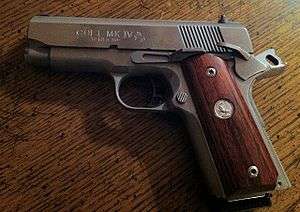Colt Officer's ACP
| Colt Officer's ACP | |
|---|---|
|
Stainless Colt Officer's ACP | |
| Type | Semi-automatic pistol |
| Place of origin |
|
| Production history | |
| Designed | 1985 |
| Variants | Concealed Carry Officer's pistol, Lightweight Officer's ACP |
| Specifications | |
| Weight | 34 oz (960 g) |
| Length | 7.5 in (19 cm) |
| Barrel length | 3.5 in (8.9 cm) |
|
| |
| Cartridge | .45 ACP |
| Action | Short recoil operation |
| Feed system |
|
The Colt Officer's ACP or Colt Officer's Model is a single-action, semi-automatic, magazine-fed, and recoil-operated handgun based on the John M. Browning designed M1911. It was introduced in 1985 as a response from Colt to numerous aftermarket companies making smaller versions of the M1911 pistol.[1]
History
In 1975, Rock Island Arsenal developed a compact 1911 it called the "General Officer's Model Pistol" for issue to general officers of the US Army and Air Force, but the pistol was unavailable for sale to the general public.[2] The following year, Pat Yates of Detonics had introduced his compact "Combat Master", a chopped down 1911, with 3.5" barrel and a shortened grip frame. Seeing the popularity of these compact pistols, other pistolsmiths began offering similar conversions on customers' 1911s.[3]
In 1985, Colt developed their own in-house version and named it the "Colt Officer's ACP", the following year they introduced a lighter version with an aluminium frame known as the Lightweight Officer's ACP which weighed 10 ounces less (24 ounces). When Colt introduced the 1991 platform (a parkerized version of the 1911, with the series 80 firing pin safety) it included a pistol of the same dimensions as the Officer's ACP.[4]
A hybridized variation with Commander-length barrel-slide and alloy Officers Model Frame. One version was made by TALO and another by the Pistol Smiths at GunSite Academy. In 2015 TALO had Colt Industries bring out a version with features specified by Wiley Clapp and fine line checkering by gun smith Pete Single.
-
Colt M1991A1 Compact bull barrel and OEM barrel bushing
-
Old Rollmark Model (ORM) M1991A1 Compact pistol
-

Talo/Wiley Clap Concealed Carry Officers Model
Although praised for its compact size, the Colt Officer's ACP has drawn criticism for being finicky with ammunition and the sharp recoil from the short barrel. Firearms Author, Frank James, writes that the decreased velocity from the shorter barrel causes performance of the round to be less than optimal when used in a defensive situation.[5]
Reliability and accuracy can be improved through modifications such as replacing the stock barrel bushing with an aftermarket part and judiciously honing the hammer and sear. Beyond trigger work, more sophisticated modifications include replacing the stock hammer and sear with lightweight components, installing a high quality spring set and beveling the inside of the ejection port.[6]
References
- ↑ Ayoob, Massad (2007). The Gun Digest Book of Combat Handgunnery. Gun Digest Books. p. 7. ISBN 978-0-89689-525-6.
- ↑ Malloy, John (2010). "The Colt 1911: The First Century". In Dan Shideler. Gun Digest 2011 (65 ed.). Krause Publications. p. 116. ISBN 978-1-4402-1337-3.
- ↑ Ayoob, Massad (2010). Massad Ayoob's Greatest Handguns of the World. Gun Digest Books. p. 25. ISBN 978-1-4402-0825-6.
- ↑ Sapp, Rick (2007). Standard Catalog of Colt Firearms. F+W Media, Inc,. p. 164. ISBN 978-0-89689-534-8.
- ↑ James, Frank (2004). Effective Handgun Defense. Iola, Wisconsin: Krause Publications. p. 185. ISBN 978-0-87349-899-9.
- ↑ Joe Gorman (2012). "Reworking the Venerable Colt Officer's Model". Middle Coast Publishing. Retrieved December 6, 2012.

